-

新人教版高中英语选修2Unit 1 Science and Scientists-Learning about Language教学设计
Step 7: complete the discourse according to the grammar rules.Cholera used to be one of the most 1.__________ (fear) diseases in the world. In the early 19th century, _2_________ an outbreak of cholera hit Europe, millions of people died. But neither its cause, 3__________ its cure was understood. A British doctor, John Snow, wanted to solve the problem and he knew that cholera would not be controlled _4_________ its cause was found. In general, there were two contradictory theories 5 __________ explained how cholera spread. The first suggested that bad air caused the disease. The second was that cholera was caused by an _6_________(infect) from germs in food or water. John Snow thought that the second theory was correct but he needed proof. So when another outbreak of cholera hit London in 1854, he began to investigate. Later, with all the evidence he _7_________ (gather), John Snow was able to announce that the pump water carried cholera germs. Therefore, he had the handle of the pump _8_________ (remove) so that it couldn't be used. Through his intervention,the disease was stopped in its tracks. What is more, John Snow found that some companies sold water from the River Thames that __9__________________ (pollute) by raw waste. The people who drank this water were much more likely _10_________ (get) cholera than those who drank pure or boiled water. Through John Snow's efforts, the _11_________ (threaten) of cholera around the world saw a substantial increase. Keys: 1.feared 2.when 3. nor 4.unless 5.that/which 6.infection 7.had gathered 8.removed 9.was polluted 10.to get 11. threat

新人教版高中英语选修2Unit 1 Science and Scientists-Reading and thinking教学设计
Step 5: After learning the text, discuss with your peers about the following questions:1.John Snow believed Idea 2 was right. How did he finally prove it?2. Do you think John Snow would have solved this problem without the map?3. Cholera is a 19th century disease. What disease do you think is similar to cholera today?SARS and Covid-19 because they are both deadly and fatally infectious, have an unknown cause and need serious public health care to solve them urgently.keys:1. John Snow finally proved his idea because he found an outbreak that was clearly related to cholera, collected information and was able to tie cases outside the area to the polluted water.2. No. The map helped John Snow organize his ideas. He was able to identify those households that had had many deaths and check their water-drinking habits. He identified those houses that had had no deaths and surveyed their drinking habits. The evidence clearly pointed to the polluted water being the cause.3. SARS and Covid-19 because they are both deadly and fatally infectious, have an unknown cause and need serious public health care to solve them urgently.Step 6: Consolidate what you have learned by filling in the blanks:John Snow was a well-known _1___ in London in the _2__ century. He wanted to find the _3_____ of cholera in order to help people ___4_____ it. In 1854 when a cholera __5__ London, he began to gather information. He ___6__ on a map ___7___ all the dead people had lived and he found that many people who had ___8____ (drink) the dirty water from the __9____ died. So he decided that the polluted water ___10____ cholera. He suggested that the ___11__ of all water supplies should be _12______ and new methods of dealing with ____13___ water be found. Finally, “King Cholera” was __14_____.Keys: 1. doctor 2. 19th 3.cause 4.infected with 5.hit 6.marked 7.where 8.drunk 9.pump 10.carried 11.source 12.examined 13.polluted 14.defeatedHomework: Retell the text after class and preview its language points

新人教版高中英语选修2Unit 3 Food and Culture-Discovering useful structures教学设计
The newspaper reported more than 100 people had been killed in the thunderstorm.报纸报道说有一百多人在暴风雨中丧生。(2)before、when、by the time、until、after、once等引导的时间状语从句的谓语是一般过去时,以及by、before后面接过去的时间时,主句动作发生在从句的动作或过去的时间之前且表示被动时,要用过去完成时的被动语态。By the time my brother was 10, he had been sent to Italy.我弟弟10岁前就已经被送到意大利了。Tons of rice had been produced by the end of last month. 到上月底已生产了好几吨大米。(3) It was the first/second/last ... time that ...句中that引导的定语从句中,主语与谓语构成被动关系时,要用过去完成时的被动语态。It was the first time that I had seen the night fact to face in one and a half years. 这是我一年半以来第一次亲眼目睹夜晚的景色。(4)在虚拟语气中,条件句表示与过去事实相反,且主语与谓语构成被动关系时,要用过去完成时的被动语态。If I had been instructed by him earlier, I would have finished the task.如果我早一点得到他的指示,我早就完成这项任务了。If I had hurried, I wouldn't have missed the train.如果我快点的话,我就不会误了火车。If you had been at the party, you would have met him. 如果你去了晚会,你就会见到他的。

新人教版高中英语选修2Unit 5 First Aid-Discovering useful structures教学设计
You have no excuse for not going.你没有理由不去。He was punished for not having finished his homework.他因未完成作业而受到惩罚。2.动词ing形式复合结构由物主代词或人称代词宾格、名词所有格或普通格加动词ing,即“sb./sb.'s+doing”构成。动词ing形式的复合结构实际上是给动词ing形式加了一个逻辑主语。动词ing形式的复合结构有四种形式:①形容词性物主代词+动词ing②名词所有格+动词ing③代词宾格+动词ing④名词+动词ingHer coming to help encouraged all of us.她来帮忙鼓舞了我们所有人。The baby was made awake by the door suddenly shutting.这个婴儿被突然的关门声吵醒了。Can you imagine him/Jack cooking at home?你能想象他/杰克在家做饭的样子吗?无生命名词无论是作主语还是作宾语都不能用第②种形式。Tom's winning first prize last year impressed me a lot.汤姆去年得了一等奖使我印象深刻。Do you mind my/me/Jack's/Jack leaving now?你介意我/杰克现在离开吗?Excuse me for my not coming on time.很抱歉我没能按时来。His father's being ill made him worried.他父亲病了,他很担心。We are looking forward to the singer's/the singer to give us a concert.我们盼望着这位歌手来给我们举办一场演唱会。
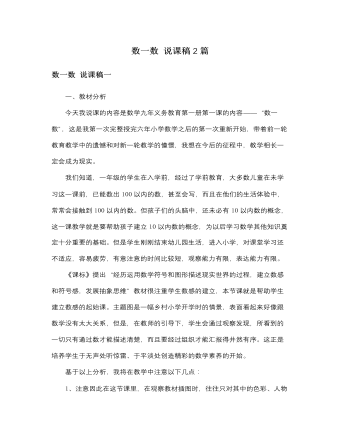
人教版新课标小学数学一年级上册数一数 说课稿2篇
为了进一步让学生掌握数数的规律,我把孩子们刚才数过的一些事物按照从小到大的顺序排列(多媒体课件),并要求学生再数一数,数完后再让他们读一读。这个环节的设计自始至终都让孩子自己去观察、动脑,主动参与到和他人的合作交流之中,在找、数和说的过程中探究新知,学会“一个一个地按顺序数数”。第三个环节:综合实践、学以致用。为了体现数学来于生活,用于生活的理念。首先,我出示了一些生活中孩子感兴趣的事物,要求孩子们正确地数出,并用数字来正确表述。此环节中,课件中所出示的图片与相应的数字一一对应,我让孩子们依次输出后,再指名同学用鼠标拖进正确的数字,孩子们觉得又新奇又好玩,纷纷要求上来试试,参与积极性非常之高。这是一个寓教于乐的环节,此环节中即让学生利用了和巩固新课中总结的新知识,又让学生在跃跃欲试的热情中感受到玩中学的乐趣。
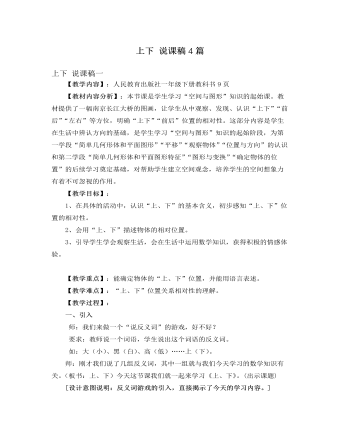
人教版新课标小学数学一年级下册上下 说课稿4篇
这一环节的设计,我运用直观和操作的方法,调动小学生耳、眼、口、手多种感官参与学习活动,并且互相配合使学生的大脑保持兴奋状态,有利于学生形成完整正确的方位要领。而且使分类与方位结合在一起,让学生在玩中逐步了解到一个数学知识不可能单一存在,在生活中处处都存在多种的数学知识。(三)练中生趣,以趣促练1、出示一副美丽的田野风光,看到这么美的场景,同学们可展开想象的翅膀,随意添上你想加的物体,并且运用学过的知识小组间互相说几句话。这时学生有的加上一轮红日,有的加有一轮明月,有的可能画上一朵小花……小组间展开了激烈的讨论,都可以准确的说出谁在谁的上面,谁在谁的下面等等这些相对位置的话。2、课件展示一所空着的4层楼房,请同学们拿出手中喜欢的动物图片贴在空房子里,互相说一说你第一层、第二层、第三层、第四层分别贴的是哪些小动物,用我们学过的知识再说一说谁住在最下面,是第几层,第二层住的是谁,它在谁的上面、谁的下面,第三层呢?
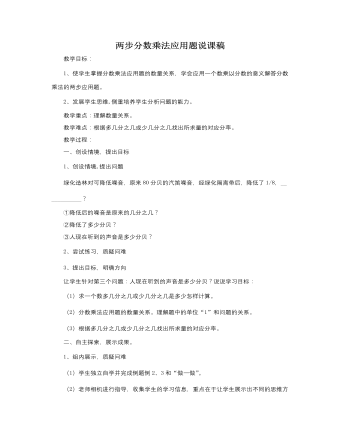
人教版新课标小学数学六年级上册两步分数乘法应用题说课稿
(三)看书质疑师:今天探索的问题与教科书第20-21页里例2-例3的内容相似,打开看看,书是怎么解答的?有疑问的可以提出来。生认真看书。生质疑。三、模拟练习,拓展应用师:请看学校调查表(课件出示),还有什么问题没有解决啊?(买折叠车和同学去秋游的人数)想解决吗?(想)师:提供这个信息能解决什么问题呢?生:买车的人数。师:你会直接口算吗?会的请你站起来告诉大家。生都站了起来了。师:这么都同学会啊,老师很为你们高兴,还是请代表说。生说。师:你们有意见吗?生:没有(好)师:谁能求出选择秋游的人数?生:不能啊,条件不充分师:那你能根据图意估计一下,然后补充一个条件,使我们能用今天的知识算出这些人数吗?
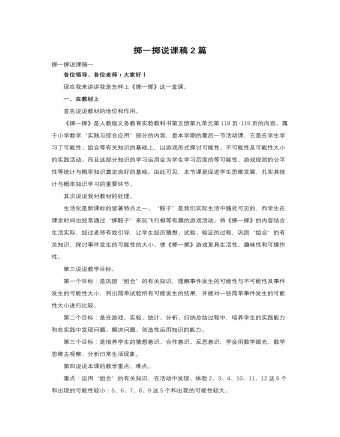
人教版新课标小学数学三年级上册掷一掷说课稿2篇
(1)猜想设疑。组织学生进行游戏实践,结果可能是选择和少的那队赢了。为什么选择和多的那队没胜,选择和少的那队却胜了呢?这里面又藏着什么奥秘呢?“猜想”是有方向的猜测和判断,是学生有效学习的良好准备。这里通过引导学生大胆猜测,由猜测结果与实际结果不同而引发学生的认知冲突,进而激发学生的求知欲,为后面的教学埋下了伏笔,从而很自然的过渡到下一个环节。(2)统计实验。这部分教学让全体学生参与获得知识的全过程,并在实验中与统计知识有机结合起来,提高了学生综合运用知识的能力。同时让全体学生参与实验统计,实验数据更加充分,实验结果与预测更加接近,从而达到实验目的。
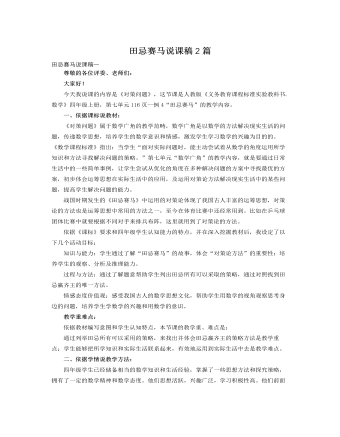
人教版新课标小学数学四年级上册田忌赛马说课稿2篇
(四)深入探究,重新审视对策问题解决问题不是学习的最终目的,让学生不断体验对策的价值才是关键所在。对策的价值在哪里?设计对策的关键是什么?把问题抛给学生去思考,一方面让学生再次感受正确对策达到“以小打大”、“以弱胜强”妙处,更重要的是让学生明确设计对策的关键前提是什么?即“知己知彼,百战不殆”的数学思想,以便根据对手的变化灵活运用对策。教学步骤设计:1、学生探讨,如果齐王的下等马都比田忌的上等马快,田忌还有获胜的可能吗?2、田忌赛马第二次获胜的前提是什么?(田忌猜测道齐王安排赛马的出场顺序还和第一次一样)3、如果齐王安排赛马的出场顺序改变了,田忌该怎样才能获得胜利?(找两位同学分角色演示一下)4、回忆课前时候,老师为什么会在纸牌游戏“比大小中”屡战屡胜。
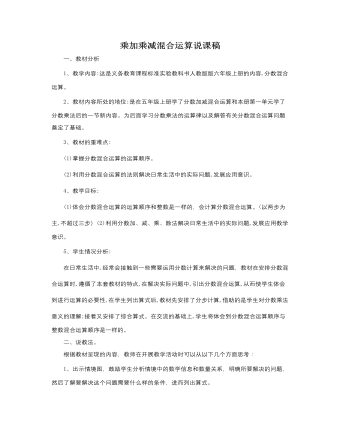
人教版新课标小学数学六年级上册乘加乘减混合运算说课稿
通过本节教学使学生学会运用直观的教学手段理解掌握新知识,学会有顺序的观察题、认真审题、正确计算、概括总结检查的学习习惯。四、教学程序一、复习1、说说每道题的运算顺序。2、问:在没有括号的算式里,如果有乘法又有加、减法,按怎样的顺序运算?在有括号的算式里,要按怎样的顺序运算?二、教学新课1、教学例2的第(1)题:说说这道题要先算哪一步再算哪一步?为什么要按照怎样的顺序运算?学生板演。2、教学例2的第(2)题。(1)说明:同样的,整数乘法的交换律、结合律对于分数乘法同样适用。(2)出示例2题(2):说说这道题例的数据有什么特点?这样算简便吗?为什么这样可以简便?应用了什么运算定律?按简便算法计算结果。3、练一练想先那些题可以用简便算法?指名板演。4、练习五2(做书上。第三题为什么可以用简便算法。)5、练习五后两题为什么这样算?三、巩固练习练习五1、3、5
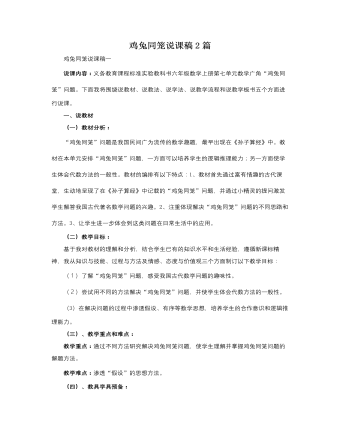
人教版新课标小学数学六年级上册鸡兔同笼说课稿2篇
2.交流讨论的结果:(老师根据学生的汇报板书)①假设都是鸡,则有8×2=16只脚,实际有26只脚多了26-16=10只脚.②一只鸡换成一只兔,就会多4-2=2只脚,所以笼子有10÷2=5只兔.③鸡就有8-5=3只.师:真是了不起,不用试也能求出鸡兔来,刚才我们是假使全是鸡,如果假使全是兔,会是怎样的情况呢?3.你还会用所学的方法解决吗?(引导学生用方程解答)4.我们已经能够用三种方法解答鸡兔同笼问题,到底对不对呢?怎样才能知道?———检验(板书)[设计意图:此环节是本课的重点,放手让学生合作探究,学生从体验、尝试到讨论、汇报,结合课件的直观演示,学生个人或集体的智慧在这里可以得到充分的展现。方程法、假设法对于大部分学生来说至少有一种方法是他自己会理解或掌握的,老师在学生汇报的过程中应机敏地倾听,机智地诱导,引导学生较为完整、准确地说明算理,特别是假设法算理,进而让全体学生在交流的过程中学会倾听、学会思考、学会解释、学会质疑,学会辩驳。]
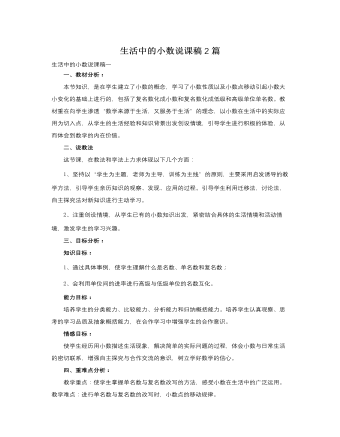
人教版新课标小学数学四年级下册生活中的小数说课稿2篇
一、教材分析:本节知识,是在学生建立了小数的概念,学习了小数性质以及小数点移动引起小数大小变化的基础上进行的,包括了复名数化成小数和复名数化成低级和高级单位单名数。教材重在向学生渗透“数学来源于生活,又服务于生活”的理念,以小数在生活中的实际应用为切入点,从学生的生活经验和知识背景出发创设情境,引导学生进行积极的体验,从而体会到数学的内在价值。二、说教法这节课,在教法和学法上力求体现以下几个方面:1、坚持以“学生为主题,老师为主导,训练为主线”的原则,主要采用启发诱导的教学方法,引导学生亲历知识的观察、发现、应用的过程。引导学生利用迁移法,讨论法,自主探究法对新知识进行主动学习。2、注重创设情境,从学生已有的小数知识出发,紧密结合具体的生活情境和活动情境,激发学生的学习兴趣。
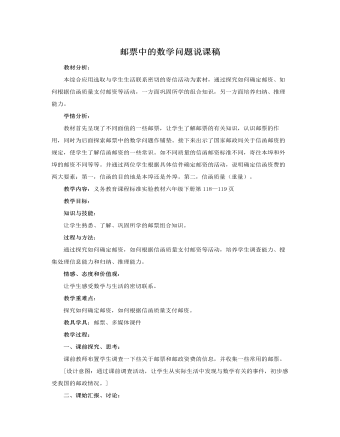
人教版新课标小学数学六年级下册邮票中的数学问题说课稿
(2)请你思考:师:这样就需要设计一张其他面值的邮票,如果最高的资费是6元,那么用3张邮票来支付时,面值对大的邮票是几元?可增加什么面值的邮票?(学生分组讨论设计思考)生:6元除以3元就是2元,可增加的邮票面值可为2.0元,2.4元或4.0元。(3)小结:虽然满足条件的邮票组合很多,但邮政部门在发行邮票时,还要从经济、合理等角度考虑。【设计意图:大胆放手,让学生参与数学活动。让学生成为课堂的主体,让他们在动手、动脑、动口的过程中学到知识和思维的方法,知识的获得和学习方法的形成都是在学生“做”的过程中形成的。】四、巩固深化:1、如果小明的爸爸要给小明回一封不足20g的信,他该贴多少钱的邮票?2、如果小明的好朋友要寄一封39g的信,他该贴多少钱的邮票?五、课后实践:课后给你的亲戚或者好朋友寄封信。

人教版高中英语必修1Journey Down the Mekong说课稿
2. let the Ss complete the forms paragraph by paragraph. Purpose here is to help Ss to get the habit of reading a passage as a whole, and pay attention to the organization of the text, as a result the Ss will fully understand the whole passage.3. ask Ss to retell the passage with the help of the key words in the form.Since the Ss in the class are in different levels, so I let them to fill in the blank to understand the meaning of the words and phrases better. ( That’s all for the while-reading. Now let’s move to the fifth step.)Step V: Post-reading (10mins) ---DiscussionIn this part students are asked to discuss in groups and list Wang Kun’s and Wang Wei’s attitudes about the trip. After that, Ss are encouraged to express their attitudes with the whole class. Collect their answers and don’t forget to praise them even if their answers may not be perfect.In this activity, discussion provides a vivid and active learning environment for Ss to communicate in English with newly learned language items. (Finally it comes to the homework.)StepⅥ: Homework (1min)1. Ss are required to read the text again after class and figure out the meaning of some complex sentences.2. Do the exercises on P19; This can help Ss to consolidate what they’ve learnt and make preparation for the next lessonPart4. Blackboard design.(说板书设计)On the top, there is the title of this lesson. On the left, there are main ideas for each paragraph. On the right, there are some new words and expressions.Unit 3 Travel journalJourney down the MekongMain idea of each para.:Para1: deciding to take a great bike trip along the Mekong river.Para2: Different attitudes between Wang kun and Wang wei.

人教版高中英语必修4Body Language说课稿4篇
Textbook: Senior English for China (Book 4), by Liu Daoyi Time Allotment: 1 period (40 minutes)Date: March 20, 2014Teaching aids: blackboard, Multi-media, Power Point, chalk I. Text Analysis (教材分析)This unit is about body language, and the text selected in the reading part demonstrates the difference and similarity of body language in many parts of the world. Through learning this passage, students are required to raise their awareness of using body language in different parts of the world. As body language is closely related to our daily life, it is easy to arouse students’ interest in learning this text. Reading skills and speaking training are designed around the text.II. Teaching Objectives (教学目标)By the end of the lesson, students will be able to:1. Language Skill Objective(语言技能目标): develop reading ability (skimming and scanning)as well as speaking ability.2. Cultural Knowledge Objective(文化知识目标): know about the cultural differences of using body language.3. Affective Objective(情感目标): increase students’ awareness of using body language correctly in different cultures. III.Teaching Focuses and Difficulties(教学重点和难点)1. Teaching Focuses(教学重点): the difference and similarity of body language in many parts of the world.2. Teaching Difficulties(教学难点): develop students’ reading abilities of skimming and scanning and ask the students to show their opinions with fluent English.

人教版高中英语必修1Nelson Mandela--A Modern Hero说课稿
In this step, give students a few minutes to read the passage . While they are reading, I will write some key words of the text on the blackboard. Then ask students to retell the passage according to the key words.By retelling, students can improve their ability of language organization and have an overall understanding of the article.Step 4 Group discussionIn this step, students will be divided into groups of 4 to discussion the following question: What qualities make a great person?After their discussion, invite a few groups to make a report to the class.This group discussion can practice students’ oral English and cultivate their abilities of cooperation and communication.Step 5. HomeworkLet students write a short passage to introduce a great person he or she admires.The homework can consolidate the knowledge the students have learned and cultivate their writing ability. Part 6 Blackboard Design(板书设计)That’s all my teaching procedures. Finally, I’d like to say sth about part 6 blackboard design. On the top is the title. On the left, there will be some new words and expressions. In the middle of the blackboard, I will write some useful sentence structures so that the students can know clearly what they’ve learned and then try to master the knowledge.OK. That’s all for my presentation. Thank you for your attention.

人教版高中英语必修2Computers说课稿3篇
一. 教材分析1. 本单元的中心话题是“计算机(Computers)”,内容涉及计算机的发展历史,计算机的应用等。本节课是该单元的第一课时,我将Warming up, Pre-reading and Comprehending这四部分整合为一节精读课。其中。Reading部分是题为WHO AM I?的文章,以第一人称的拟人手法介绍了计算机发长演变的历史和计算机在各个领域的应用,其主旨是表达计算机的发展变化之快以及在生活中用途之广。而Warming up部分以图片的形式展现了计算机的发展历程;Pre-reading中的问题和排序分别是为了预测语篇的内容和测试学生对计算机历史了解的情况;Comprehending则通过各项练习训练学生的阅读技能,从而加深对文章的理解。可见这几部分是一个有机的整体。2. 教学目标:1) 语言目标:重点词汇及短语:abacus, calculate, calculator, PC, laptop, PDA, robot, analytical, technological, universal, mathematical, artificial, intelligent, network, explore, in common, as a result.重点句子:a. My real father was Alan Turing, who in 1963 wrote a book to describe how computers could be made to work, and build a “universal machine” to solve any mathematical problem.

人教版高中英语必修2Cultural Relics说课稿2篇
Ⅲ. Analysis of the teaching material:The topic of this unit is cultural relics. Students are quite interested in topics about different cultures around the world. This is the second period of the whole unit. As a reading class, the passage mainly talks about the history of the amber room (how it was made, sent as a gift, lost and rebuilt).According to the new national curriculum, when teaching reading, much emphasis should be put on training the students’ reading skills.Ⅳ. Teaching objectives1. Language objectives:1) Students are required to master the key words and phrases occurred in the passage (e.g. amazing, decorate, belong, in return, less than etc.)2) Students are required to learn the attributive clause and acquire the sentence pattern.2. 1) Students are required to describe a certain thing by using the new sentence patterns.2) Students are required to master two kinds of reading skills—skimming and scanning, and learn to use them in their daily reading.3. 1) Students are required to know the history of the amber room.2) Students are required to appreciate cultural relics and understand the importance of protecting them.Ⅴ. Teaching important and difficult points1) the new words, phrases, and sentence pattern in the course of reading.2) Teaching difficult point: Help the students master two kinds of reading skills—skimmingand scanning and learn to apply them in daily use.Ⅵ. Teaching methods:Task-based method & Top-down model Ⅶ. Teaching aids: PPT, pictures, blackboard Ⅷ. Teaching procedure:

人教版高中英语必修2The Olympic Games说课稿2篇
Purpose of my design:To ask the students to do these two tasks will make the Ss predict the story of this passage. As a result, it will deepen Ss’ memory of this story because they will have their own understanding of this story.Step 3. While-readingTask 1. (Individual work _____min)Skimming: ask students to skim the text and the main ideas of each paragraph in this passage. Please read it quickly and then match the sentences with the letters.Task 2. (Individual work _____min)Scanning: read the text quickly and decide the whether the following statements are true or false and give reasons.Task 3. (Pair work _____min)Listen to the tape and fill in the banks. Then read the paragraph with expression to your partner.Task4 (individual work min)Listen to the tape again and write down the main idea in one sentence.Purpose of my design: Enable students to understand the given material better by using different reading skills. And proper competition can arouse the Ss’ interest in English learning. “Task-based” teaching method is used here todevelop the Ss’ ability of communication and also their ability of co-operation will be well trainedStep 4. Post-readingTask 1. (Individual work, pair work, group work, class work; _____min)Discussion (group of 4):1. If you were Hippomenes, would you run against Atlanta?2. Do you think Hippomenes deserved to win the race? Why or why not?Step 5. HomeworkPlease read the story again carefully after class and imagine: What will happen during the race between Hippomenes and Atlanta? Who do you think will win the race? Do you think Atlanta would marry Hippomenes? Write an end for the story with thses questions.Purpose of my design: Homework is so important and necessary for to master the knowledge they learned after class. It will check whether the Ss achieve the teaching aims.Part 5 Blackboard design

人教版高中英语必修3Astronomy the science of the stars说课稿3篇
Step 2 Pre-listeningAfter students finish their discussion, I will show a picture of Newton and ask them: Who is him? What is he famous for? Could you find out some words to describe him? Maybe students will answer that he is genius for his finding of theGravitation, making a great contribution to the progress of human being. At that time I will show another two pictures of Einstein and Hawking, letting students guess who they are and write down their idea about the Gravitation. For I have arranged them to search more information about the gravity before this class, Students have beenfamiliar with the topic and will not be afraid about this abstract conception, which is helpful for their listening.Step 3 While-listeningIn this step, students will be required to listen the material for three times. The first and listening is extensive listening and the second and third listening is intensive listening. In the first time, They are required to listen a material including Part 1 and Part 2 and choose the best summary of the listening text. After they choose the right answer, They also need work in group to explain what is wrong with the others. Then I will make a conclusion that we should pay attention to the first paragraph and last paragraph and some keys to get the main idea. By doing this, their capacity of generalization will have a great improvement.Before the second listening, I will ask students to scan the blank on the power point quickly and ask them to note down some key words .Then ask them to listen to the Part 1again and fill the first column of the chart. Maybe some students just show the ideas of these three scientists an still can’t catch their development of gravity. Therefore, I will ask them to listen to Part 2 again and fill in the rest. After finish the listening, I will give them ten minutes to discuss with their partner. I will also guidethem to improve their answers when they discuss with others.

